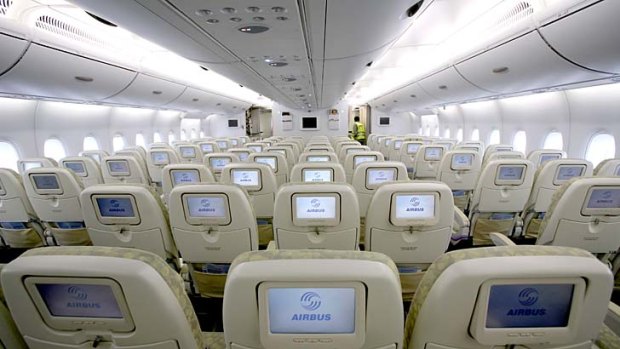
Airbus about to unveil a new A380 interior design that squeezes in an extra economy class seat.Credit: AP
What's worse than a cramped economy seat with limited leg room and a seat reclined onto your dinner tray? Plane manufacturer Airbus has come up with an answer: jam an 11th seat into economy-class rows of the A380, the world's largest passenger jet, for a 3-5-3 seat configuration.
According to Flightglobal, an aviation website, a mock-up of this new 11-abreast seat configuration will be shown at an aircraft interiors trade show in April. The website reports that an aircraft leasing company is eager to get it into the hands of airlines worldwide.
Being boxed in a middle seat by four people is seemingly not the future air travellers were promised when the A380 was announced in 2000. Back then, the giant plane - according to Airbus it has enough room to seat about 525 passengers in a "comfortable three-class configuration," though actual configurations vary - was expected to usher in a new era of airborne luxury, the likes of which hadn't been seen since the mid-twentieth century's so-called "golden age" of air travel.
In its March 2001 issue, for example, Popular Mechanics, a reliable tribune for future-hype, published a cover story with the headline "Hotels in the Sky;" it explained:
"Stop at the bar for a couple of beers, then work them off in the gym. Shave, shower and meet the wife at her health spa. Tag along while she shops. Have a gourmet dinner, then light up a Cuban cigar and sip cognac at a small piano bar. Log 8 hours in the sack, eat a leisurely breakfast and collect the kids and Rover. Then move your seat to the full upright position, because this hasn't been a getaway weekend. You've flown from New York to Sydney aboard the Airbus A380, the world's first flying hotel."
That wasn't all. In December 2000, Wired ran an Associated Press article with the headline "The Casino in the Sky," which suggested the possibility of bars and gambling. As recently as 2007 Virgin Atlantic's Richard Branson was promising "roulette and blackjack" which - in addition to double beds - Branson proclaimed in 2005, could provide passengers with "two ways of getting lucky." By the time the marketers were finished, it seemed the only thing a spacious A380 cabin would lack was a dance floor and mirror ball.
Reality, however, was much more dull. Casinos haven't materialised, and though some A380s have bars, and you may be able to walk around the duty-free shop on your Korean Air flight, from a passenger perspective what distinguishes the A380 interior is little more than size and a quiet environment.
So how did Airbus go from offering a futurist's dream of airline paradise, to possibly a frequent flyer's nightmare? In part, the A380 was designed for a regulated hub-and-spoke model of running an airline - fly big planes long distances and little ones short distances - that's increasingly out of favor in a world where deregulation allows more airlines to fly more places on fuel efficient midsize planes that carry fewer passengers. If you're trying to get from Shanghai to Seattle, you can now simply go directly with about 200 other passengers on a Boeing plane (via Delta). Indeed, Boeing - Airbus's great rival - makes planes, including the slick, smaller 787 Dreamliner, designed for precisely that kind of point-to-point aviation universe.
The proof is in the results. Airbus initially aimed for 750 total orders for the A380. At the end of 2013 it had just over 300 total orders; almost half of those were made by Dubai-based Emirates, which runs a successful hub-and-spoke business shuttling passengers between major airports around the world, and delivering them to Dubai, where they transfer - often to other A380s. And that's largely a volume business, not a luxury one.
The 3-5-3 seating configuration has only just become an option, and so it's unlikely to land at your local hub any time soon. But fliers shouldn't rest easy. According to Bloomberg Businessweek, the British leasing company that purchased 20 planes earlier this year, and pushed for the 3-5-3 seating configuration, has suggested that the A380 should operate with about 630 seats for increased efficiency. If that comes to pass, the likelihood of being stuck in an uncomfortable middle seat - including one jammed between four other seats - just went up.
THE WASHINGTON POST
Sign up for the Traveller newsletter
The latest travel news, tips and inspiration delivered to your inbox. Sign up now.